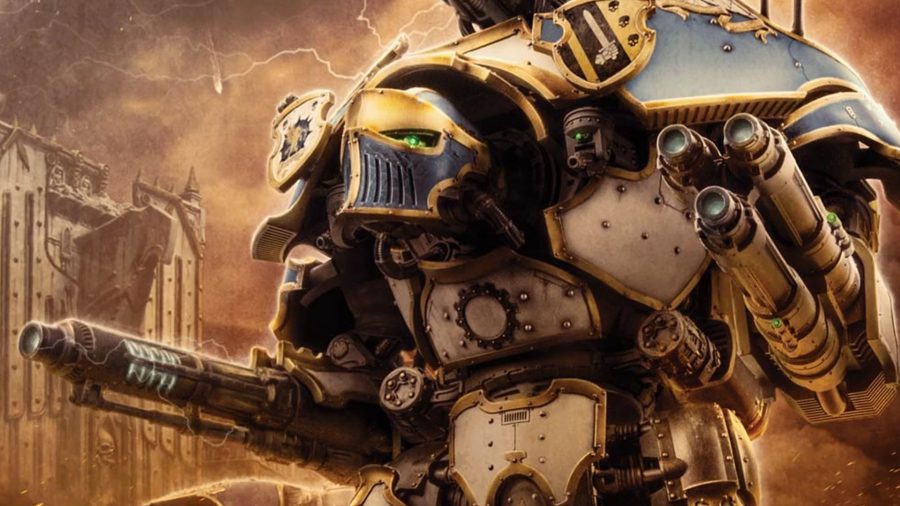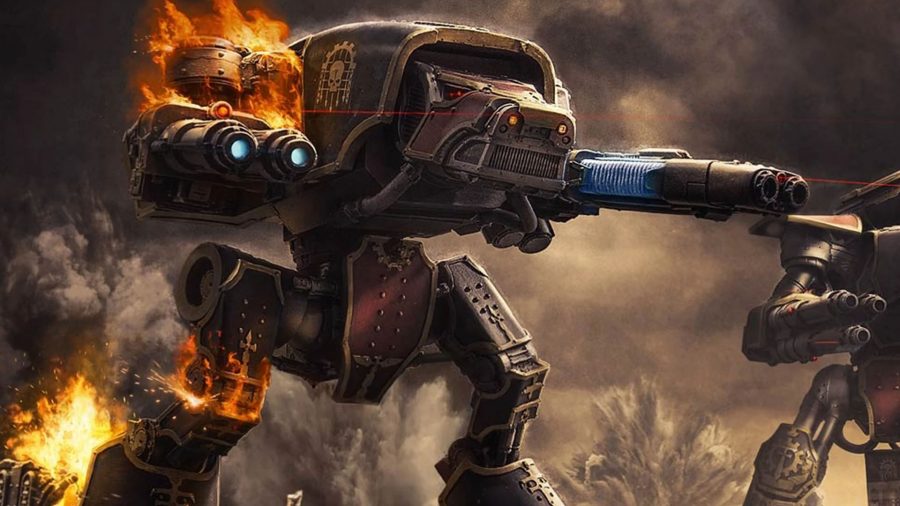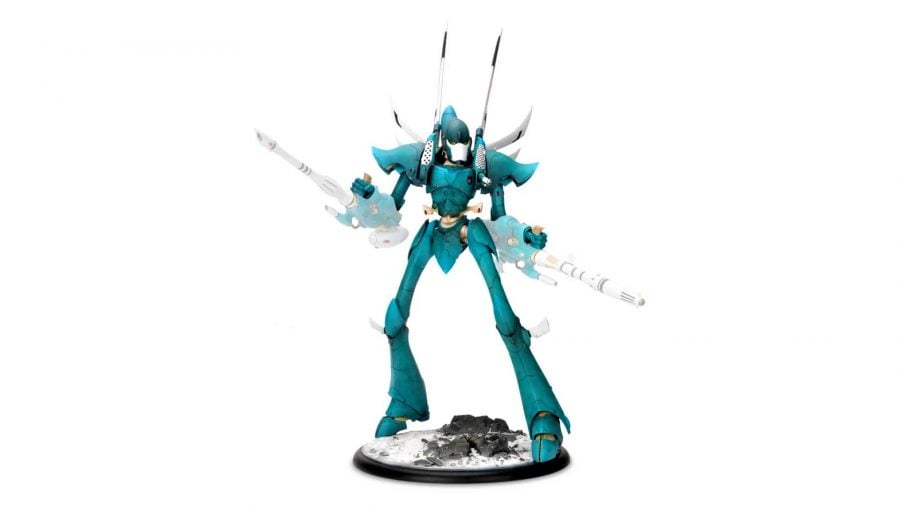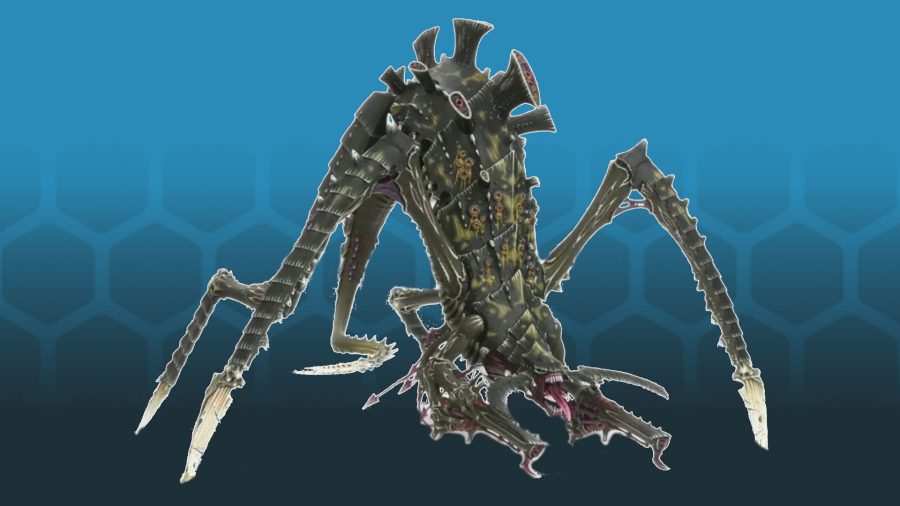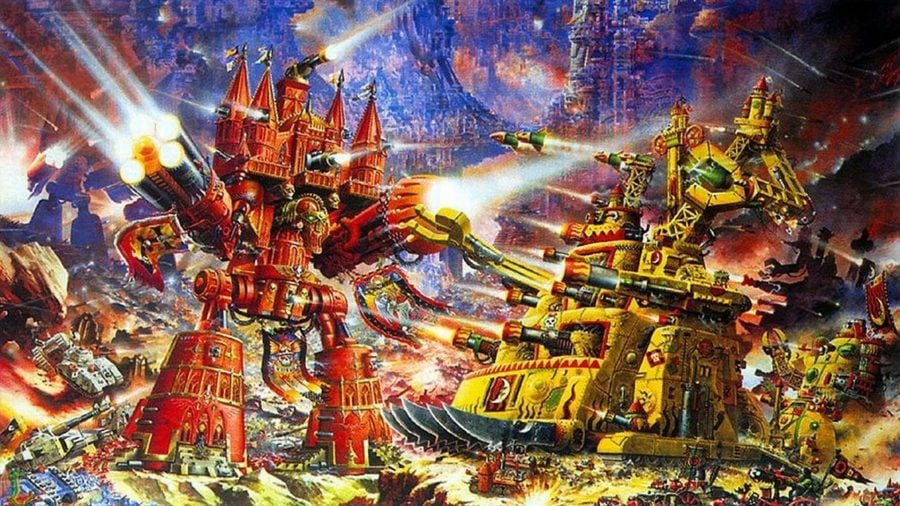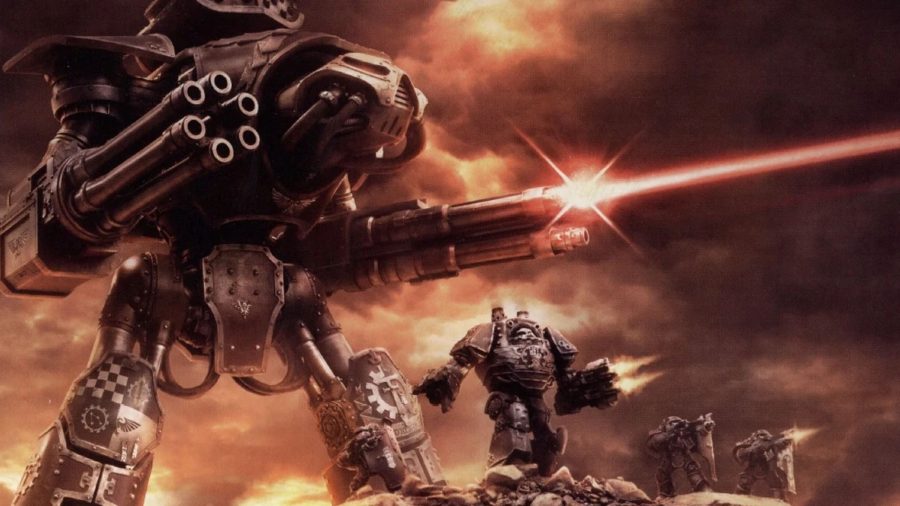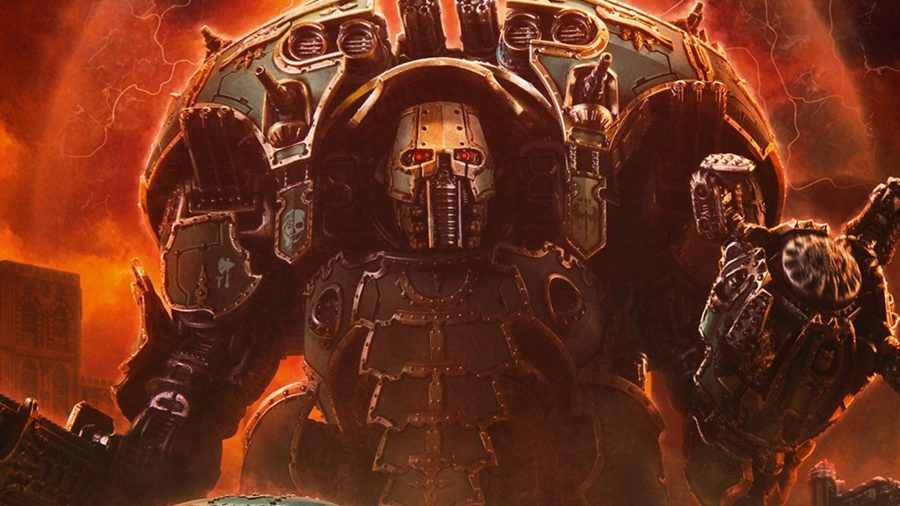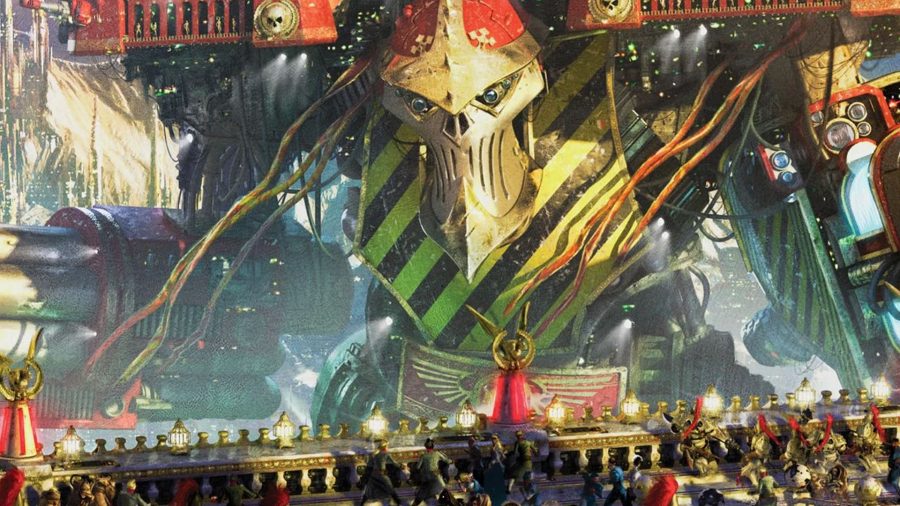To understand Warhammer 40k titans, you have to understand that the universe of Warhammer 40,000 is one where hyperbole knows no limits. Gods and daemons clash for the souls of humanity, aliens eat entire civilisations to feed their eternal hunger, and magic-like psychic powers are tossed about with an abandon that would make Tolkien blush. The scale of Warhammer 40k is so large it beggars belief, so it’s only natural that the game’s miniatures are also pushed to the limit in the form of Warhammer’s titans.
You won’t see titans played on the tabletop often but, when you do, it’s always an event. So large they could almost be considered ‘maxiatures’, they exemplify the spirit of colossal warfare more than anything else you can get your hands on. They are giants in name and giants on the tabletop too.
In the lore, they stand even taller – god-machines that loom above the battlefield like sky-piercing nightmares of flesh and steel. Creations so large they blur the lines between mountain, building, and machine. Come with us on a journey to feel the thunder of their passing, as we look at what titans are – and how you can play them in Warhammer 40k.
Many races and faction in Warhammer 40,000 have their own titans, each reflecting the doctrine, culture, and technology of the species that created it.
These range from fleshy Tyranid Bio-titans to stalwart relics crafted through forgotten Imperium technology. In addition to having strong appearances in the various works of fiction, titans can also appear on the tabletop, though not all have models currently available for purchase.
Here’s what to know about Warhammer 40k titans:
Imperial titans
Imperial titans are the might of the God-Emperor of Mankind made physical. Warhammer 40k’s Imperium of Man is fading, beset on all sides by enemies and controlled by a doctrine that prevents innovation. As a result, each Titan represents a worth more valuable than entire planets, as they cannot be replaced. Maintained by legions of dedicated Adeptus Mechanicus tech-priests; crewed by Collegia Titanica specialists; and flanked by liveried lances of noble Imperial Knights; Imperial titans are vast icons of worship as well as tools of war.
Titans, as befits the name, can come in a range of colossal sizes, each designed to fill a particular role on the battlefield.
Warhound titans
Warhound titans are fast, mobile creatures that hunt across warzones. Smaller than many of their siblings, they still stand 15 metres (45 feet) tall. Imagine them like their namesakes; they hunt, they flank, and they team up to take down larger prey.
Warlord titans
The most common Titan in the ranks of the Imperium is the Warlord battle titan. Standing 33 metres (108 feet) tall, Warlords can be equipped in a variety of ways, with loadouts that range from Volcano Cannons and Vulcan Mega-Bolters to Arioch Power Claws. Warlord Battle titans have several subclasses, named ‘Patterns’, which further increase their versatility on the battlefield. For example, Mars Pattern Warlord titans are of ancient design, dating back to the ancient forge world of Mars itself. Fitted with a devastating bevy of guns, a single Mars Pattern Warlord Titan can turn the tide of a war in moments.
Emperor titans
Finally, the largest type of Imperial Titan is the Emperor titan, which has two subclasses: Imperator titans and Warmonger titans. These walking fortresses are so large they can almost be considered moving mountains. In addition to their truly awe-inspiring amount of weaponry, Emperor titans can carry entire companies of troops. Simply put, if you see the crenelated crest of an Emperor Titan rising above the horizon, run.
Chaos Titans
After the Horus Heresy, the traitor legions fled to their various hiding places amongst the stars. They didn’t flee alone, however; many Adeptus Mechanicus (then called Mechanicum) factions turned traitor along with Horus and, when they found themselves on the losing side of the war, fled alongside their Chaos Space Marine brethren.
Titans also made the journey to the Eye of Terror along with their disgraced Chaos-aligned Collegia Titanica crews. As a result, many Imperial titans have their dark mirrors amongst the forces of Chaos, albeit with twisted Dark Mechanicus alterations and daemonic infestations.
Chaos Reaver titans
Chaos Reaver titans are one of the more common Chaos titans encountered on the battlefield. Smaller than Warlord Battle titans, but larger than Warhound titans, they carry heavy weapons that can inflict a heavy toll on their opponents’ forces. Inside they differ vastly from their Imperial cousins, with their crews and even internal architecture possessed entirely by daemons, making them breathe with an unholy life.
Chaos Warlord titans
In addition, Chaos Warlord titans have been spotted striding distant worlds, destroying all they encounter. Similar at first glance to original, loyalist Warlord titans, it’s only with a closer look that their aberrations become apparent.
Serve the powers: Our guide to Warhammer 40k chaos factions
Instead of holy Imperial iconography, these machines are covered in runes and other daemonic symbols. In addition, their weaponry can be vastly different, including cruel Chaos Energy Whips and Chaos Titan Tails.
Eldar Titans
Where Imperial titans are heavy, squat machines that brute-force their way into every forward step, Eldar titans are vastly different. Graceful, slim, and impossibly tall, the titans of Warhammer 40k Eldar armies don’t walk the battlefield – they appear to dance through it.
Eldar titans move with almost impossible grace
Constructed of wraithbone, that same mysterious material used for many of the Eldar tanks and even their Craftworlds, Eldar titans incorporate fallen Aeldari spirits at their core. Their crew are often twins or triplets, raised alongside the titan in lockstep from birth, becoming emotionally bonded with the spirit inhabiting the titan.
It’s this bond that can make Eldar titans appear almost supernatural when fighting, acting with a grace and speed that seems impossible for a war machine of such size.
Eldar Revenant titans
Revenant titans take the approach to gracefulness to extremes. The smallest type of Eldar titan, Revenant titans can leap and run across the battlefield faster than any opponent can believe. Similar to Warhound titans, they tend to act in packs, using their deadly weaponry to gang up on tougher targets and bring them down.
Eldar Phantom titans
At the other end of the scale come Phantom titans. They tower over their foes but still move with the speed and skill expected of the Eldar, their Steersmen fully integrated into one gestalt entity inside the titan. Armed with the most powerful weapons the Aeldari can muster, Phantom titans can often be seen with Phantom Titan Pulsars, Distortion Cannons, or even Ashuna-Valcry’le Power Glaives.
Warlock battle titans
Warlock battle titans take the merging of soul and titan to the logical conclusion, by bringing together the souls of dead Warlocks with these titanic Wraithbone bodies. This gives them psychic powers they can unleash, along with foresight born of their innate witch sight. This makes them especially powerful against foes born of the Immaterium, such as the forces of Chaos.
Tyranid Bio-titans
Much like the Tyranids themselves, Tyranid Bio-titans are utterly alien and are grown rather than constructed.
Formed out of several different giant creatures, Bio-titans can take on a multitude of different forms depending on the requirements of the greater Hive.
Space oddities: Our guide to Warhammer 40k xenos factions
Tyranid Hierophants are flesh made into walking battle platforms. Hideous, spider-like creatures that scuttle with heavy steps over the battlefield, Hierophants are amongst the largest Bio-titans that anyone has yet encountered (or rather, encountered and survived long enough to report back about).
Armed with huge Bio-Cannons, chitin blades, and claws that can rend metal as easily as flesh, they are an existential threat larger than almost any encountered by the Imperium of Man.
Ork Gargants
Warhammer 40k Orks make their titans much like they do all their technology. They smash things together, use a bit of luck, throw in a dash of some half-forgotten, inborn understanding of technology, and an Ork Gargant is the final result.
Ork gargants look like they shouldn’t work at all – but they do
Devoted to their twin gods, Gork and Mork, and even shaped in their image, Gargants are technological marvels. By that we mean it’s a marvel they work at all, as they appear to be more moving rubbish heaps than defined machines crafted to a singular purpose. Instead of sleek lines – as seen in Eldar titans – or even the square, brutish architecture of Imperial titans, Ork Gargants look almost like steam tanks, if steam tanks could stand hundreds of feet tall.
Though simpler than other variants of Titan, Gargants are still utterly deadly in combat and veritably bristle with armaments. Their most iconic weapon is the belly gun, which tends to hold a Gut Buster mega-cannon capable of spitting out shells the size of Warbikes. Gargants may look simple, but this simplicity belies a destructive capability on par with the best any other faction can field.
Where to buy Warhammer titans
Now we’ve covered what titans are, it’s time to take a look at how you can get your own hands on one, as well as a quick primer on how they perform on the tabletop.
Titans, like in fiction, are an investment. There’s no denying that, if you want to own a Titan for your very own army, then it’s not something to get involved in lightly.
The Warhammer 40k section on the Forge World website is the best place to start your journey towards Titan ownership. There you can browse all the Forge World titans, from Chaos Reaver titans and Warhound titans to Mars-Alpha Pattern Warlord titans.
Shorter legs: Our guide to Warhammer 40k Imperial Knights
This process is extremely customisable, unlike buying many models off the sprue. Typically you’ll buy the body, and then pick out your own weapons in order to arm your Titan. There’s also a Forge World Titan Builder service, though this only covers three types of Imperial Titan. If you’re looking for a Chaos Titan or Eldar Titan, you’ll have to pick out your armament yourself.
The exception to this is the Tyranid Hierophant Bio-Titan, which comes with one loadout. This makes the Tyranid option the cheapest for prospective Titan-fans, with other factions’ titans reaching well over $1000 for the full kit.
If (like us) your budget doesn’t quite stretch that far – you can always try GW’s recently expanded Adeptus Titanicus miniatures game, for which we’ve provided a few example kit links here.
Warhammer 40k titan rules
You’ve bought a Titan for your army, you’ve painted it (well done, that takes a while), and now you’re ready to deploy it on the battlefield against an unsuspecting foe.
Titans cost thousands of points to field – but have the power to match
The first thing you’ll need are the appropriate rules – found in the Imperial Armour Compendium, also available from Forge World. This will give you all the Heavy and Super Heavy rules you’ll need to be able to use your Titan. Inside this book, you’ll be able to take a closer look at how differently titans play from the Warhammer 40k armies you may be used to. We’ll focus on Imperium titans for this section, as they’re the most commonly seen in Apocalypse Warhammer 40k games.
The first thing to consider is the points value. Even the smallest Titan will be several levels more expensive to field than any other unit or model. Titans can rack up thousands in points and hundreds in power level before they’re even fully kitted out, so be aware that much like the price to purchase them with hard cash, they may only see occasional use when playing Warhammer 40k.
That’s the downside out of the way, now onto why you’d want to take one. Firstly, they just soak up damage. Many titans can have over a hundred wounds. Your opponents will have to be shooting all day just to bring your new Warlord titan down.
Combine that with Imperial titans’ trademark Void Shields that give them a great save, along with multiple layers that need to be brought down before damage can be done – and a toughness that will befuddle all but the most doughty of weapons – and any titan you field is going to be one tough cookie.
Titandeath: Learn history with our Horus Heresy book list
Their armament is where the excitement truly sets in. A titan can lay down army-withering amounts of fire and, and is a terrifying threat to anything set against it, whether in melee or ranged battle. For example, some calculations have put a Warlord titan’s average damage output at roughly 164 wounds. Per turn. From shooting alone. Spread that out amongst an army and you’ll be seeing a lot of models being removed to your opponent’s carry case.
In melee, titans can be even more deadly, with specialised close-combat weapons that can devastate anything foolish enough to stand toe-to-toe with them. Even the Titan’s body itself is a weapon, with its feet being able to crush anything that doesn’t hustle fast enough to get out of the way.
Even if your titan should face death, it’s possible for it to deal damage if its reactor overloads. This has the potential of dealing 3D6 mortal wounds to every model within 4D6 inches. If there’s anything that’ll turn a moment of victory into a crushing defeat, it’s that.
Titans are colossal in every sense of the word. From their lore and backstory to their size on the tabletop to the threat they represent for your friends should they attempt to take you on. This is entirely as they should be, they’re titanic, after all.
Source: Wargamer




